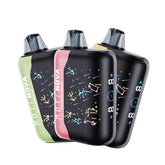How Many Calories in a Vape Hit? Here’s the Complete Breakdown
When it comes to vaping, many people wonder about its health effects—especially how many calories are in a vape hit.
While vaping is mainly about nicotine, the idea of calories in vape liquids is worth exploring, especially if you track what you consume. Vaping isn’t like eating or drinking, so you’re not taking in calories the usual way. But do vape ingredients contain any calories at all?
If you’re health-conscious or just curious, understanding this can help you make more informed choices.
Content Table:
- Do Vapes Have Calories?
- What Factors Affect the Calorie Content in a Vape?
- How Many Calories Are in a Vape Hit?
- Can You Absorb Vape Calories Through Your Lungs?
- Do Vape Brands Differ in Caloric Content?
- FAQs
Do Vapes Have Calories?
Yes—but only in trace amounts. Vapes contain small quantities of calories due to their core ingredients: vegetable glycerin (VG) and propylene glycol (PG). These two are responsible for producing the vapor you inhale and are considered food-grade substances.
-
Vegetable Glycerin (VG): Contains approximately 4 calories per gram
-
Propylene Glycol (PG): Also contains about 4 calories per gram
Other components in vape juice such as nicotine, water, and flavorings contribute little to no calories. However, it’s worth noting that even though VG and PG contain measurable calories, they’re inhaled, not digested—meaning your body doesn’t absorb them the way it does with food or drink.
What Factors Affect the Calorie Content in a Vape?
Several elements can influence the caloric content of a vape:

-
E-liquid Composition: The main ingredients in e-liquids, Vegetable Glycerin (VG) and Propylene Glycol (PG), can slightly affect calorie content. Higher VG or PG concentrations may add a few more calories, but the difference is minimal and unlikely to be noticeable.
-
Flavorings: Flavorings, especially sweet or dessert-inspired ones, can add trace calories. While the amount is usually negligible, some complex flavors may contain small caloric compounds.
-
Nicotine Levels: Nicotine is virtually calorie-free and doesn’t impact the caloric content of e-liquids. The calorie count mainly comes from the other ingredients.
Despite these factors, the total calorie count remains minimal, posing no significant impact on daily caloric intake.
How Many Calories Are in a Vape Hit?
If you're wondering how many calories are in a vape hit, the answer is: approximately 0.05 calories per puff. This is an extremely small number—but it’s worth breaking down precisely, especially if you’re counting every calorie or managing weight.

So, where do these vape puff calories come from? The small amount of energy in each hit comes from the two main ingredients in e-liquid: vegetable glycerin (VG) and propylene glycol (PG). Both of these compounds are technically caloric, containing around 4 calories per gram. However, the way they are used in vaping makes the calorie count almost negligible.
Let’s do the math:
-
1 mL of vape juice contains about 5 calories
-
Each 1 mL gives around 100 puffs
-
5 ÷ 100 = 0.05 calories per puff
That’s your answer: each vape puff contains 0.05 calories.
This applies to all common vape types:
-
A 1 mL pod vape = ~5 total calories
-
A 2 mL disposable vape = ~10 calories in total
-
A 10 mL high-capacity disposable (like a Geek Bar Pulse) = ~50 calories across its lifespan
Even if you vape an entire 10 mL device, you’re only consuming the equivalent of one bite of food. Since vaping involves inhalation rather than ingestion, the majority of the calorie content is not absorbed by the body. Instead, it is aerosolized and exhaled.
Why Is This Important?
The question “Do vapes have calories?” has become a popular search query, with “how many calories are in a vape hit” emerging as a high-intent keyword. This topic is particularly relevant to fitness-conscious individuals, diet-focused users, and those simply seeking accurate information rather than assumptions.
To clarify: vaping does contain calories, but its impact on your daily caloric intake is negligible. However, understanding the data can be helpful, and this breakdown provides the exact numbers you’re looking for.
Can You Absorb Vape Calories Through Your Lungs?
Is vaping contributing to your daily calorie intake? The short answer is no. While vape aerosol contains compounds like VG (vegetable glycerin) and PG (propylene glycol), these are not metabolized for energy in the same way as food or beverages.
Most of the aerosol either evaporates or is exhaled, with minimal absorption by the body. As a result, vaping—even in significant amounts—does not affect your calorie count or contribute to weight gain through caloric intake.
While there are various health considerations associated with vaping, adding extra calories is not one of them. It does not impact your diet or calorie goals in any measurable way.
Do Vape Brands Differ in Caloric Content?
Yes, but the differences are minimal. Most vape juices are formulated with similar base ingredients—vegetable glycerin (VG), propylene glycol (PG), and flavorings—though specific formulations can vary between brands.

For instance, high VG blends may contain slightly more calories per milliliter compared to 50/50 blends. Conversely, nicotine salt-based vape juices often utilize thinner formulas with less VG, resulting in a lower caloric concentration per puff.
Nicotine-free disposable vapes may include additional sweeteners or fruit-based flavor extracts to enhance taste, but these additives typically have a negligible impact on calorie content. Overall, the variation in caloric content across brands is minimal, rarely exceeding 1–2 calories per milliliter.
FAQs
How many calories are in a vape hit?
The calories in a vape hit are calculated based on the low levels of energy provided by the vapor. Since vape liquids primarily contain substances like glycerin and flavoring with fewer calories than food or drinks, their contribution to overall energy consumption is minimal.
Can vaping affect weight management?
While vaping itself provides fewer calories and does not significantly contribute to calorie consumption, smoking cessation through vaping can impact weight management. Pairing vaping efforts with a balanced diet and understanding its effect on cravings is crucial for long-term weight loss or maintaining a healthy weight.
Does vaping compare to cigarette smoke in terms of calories?
Cigarette smoke, like vaping, contains low levels of calorie energy. However, the flip side of both habits is their potential exposure risks. For weight loss and digestive system health, it’s essential to consider overall health habits, including a balanced approach to calories, carbohydrates, and fat intake.
Are there other factors to consider alongside calorie consumption from vaping?
Though vaping contains fewer calories, weight management involves more than just the energy provided by a vape hit. Studies suggest that focusing on the importance of a balanced diet, reducing alcohol consumption, and accounting for the range of risks associated with vaping or smoking is crucial to achieving a healthy lifestyle.
Summary
Vape juice has barely any calories—ingredients like vegetable glycerin and propylene glycol contribute so little that it won’t affect your daily intake.
Plus, since vaping doesn’t lead to traditional calorie absorption, it’s not likely to cause weight gain, especially if you’re choosing nicotine-free options. So, if you’re keeping an eye on your diet, there’s no need to count vape hits in your calorie tracker.
Whether you’re health-conscious or just curious, vaping isn’t going to throw off your diet. Relax and enjoy without the guilt!
















